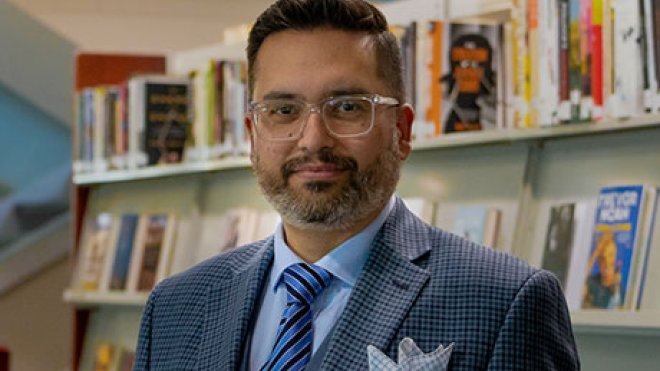6 Questions on Psychological Well-Being Among the Latinx Population
Professor of Psychology Alejandro Leguizamo studies the factors of what enables people from diverse populations to lead happy lives

BRISTOL, R.I. – After practicing many years as a clinically-trained psychologist studying the causes of disorders, Alejandro Leguizamo decided to turn his investigations toward “what goes right” for people.
For the past several years, Leguizamo, an associate professor of psychology at Roger Williams University, has directed his research to the field of positive psychology and determining which factors of psychological well-being contribute the most toward a happy life. With his most recent focus on the Latinx population, he’s conducted national surveys of Latinx individuals measuring their feelings of optimism, satisfaction in life, hope for the future, mindfulness, interpersonal support, spirituality, how they cope with discrimination and their level of resilience, among other factors.
“I’m studying what contributes to psychological well-being among populations – what leads people to lead good lives, to be happy, to succeed, and to be well off psychologically,” Leguizamo said.
Recently concluding his research into the Latinx population, he’s also investigated psychological well-being in the white population across America and next fall plans to begin studying the African-American population. His goal is to develop a model that illuminates which factors best predict psychological well-being, helping inform the psychology and medical community with a way to evaluate a person’s emotional state and environmental conditions and offer a guide for boosting good practices as treatment.
Why do you focus on one cultural population at a time?
Traditionally in psychology, the impetus has been to compare populations. However, part of the issue with that approach is that populations have been compared to white, middle-class, male Christian heterosexuals, and then it becomes a matter of seeing if differences are found and those differences can be seen as being strange because they don’t fall within that societal norm. More recently, what has been recommended, and what I’m doing, is to approach the study of diverse populations by themselves in order to understand more about them, without having to compare them with what appears a normative population.
Why is it important to understand the cultural influences in a person’s psychological well-being?
Once we understand a population by itself, then we can assess cultural factors that could be translated to other populations. For example, increased sociability and social support may be emphasized in some cultures more than others, yet we know that isolation, for example, is more dangerous than smoking.
In some cultures, outward expression of emotion when in distress is not encouraged, particularly in Asia, but also among males in many Western and non-Western societies. Distress tends to be expressed in Asian societies as physical ailments – headaches, digestive issues, for example – while males in many cultures opt for aggression or substance use as a way to express/cope with distress. For males in American culture, sociability tends to involve activities rather than emotional rich interactions or physical affection with other men. Yet, we know that isolation is detrimental to the person, most of all, since it can lead to depression and poor physical functioning, but also to others at times, since it can lead to some types of aggression for some, such as sexual aggression.
What has your research revealed about ethnic differences in predictors of psychological well-being among the Latinx population?
We have found that not all of the factors have been predictive. We have found that a person’s resilience is important and predictive, and also interpersonal support, mindfulness, perceived stress – so the less stress they perceive they are experiencing, the better off they are. How well they think they’re doing in comparison to others, how hopeful they are of the future, and if they experience less discrimination – all are related to well-being in the Latinx population.
What was surprising for this population, was that satisfaction of life wasn’t predictive, neither was being happy, neither was spirituality. This was an initial run, so we will do further analysis to see if there are interactions among, for example, spirituality and support to see if they’re getting the support they need from their spirituality.
What will a model for psychological well-being contribute to your field?
Because then we can know what factors outside of the therapy session will be important to keep an eye out for or help build up in order for the person to be better off psychologically. Treatment can focus on building resilience skills in order to raise their level of resilience, building hope and skills to relieve stress, fostering mindfulness. Or the person can be connected to community support either from family members or community organizations; particularly if the person is a recent immigrant, they may not have the network.
You’re an advisor for the Hispanic and Latino Student Association (HALSA) at Roger Williams University. Why is it important for students to have community groups like these?
For social support, which is tremendously important. For students to be able to have a space where other like students understand them and they can have fun. For Dominican Republic Independence Day they held an event with a poet from Providence, and afterward students put on Dominican music and played dominoes.
Why do you bring the study of diverse populations into your classroom?
This is important work, because as a field we have ignored minority populations for a long time. My goal is to have students get used to the ideas of considering diversity issues in their research, whether they’re minority students or not, and to consider how important those factors are for their own research. And it’s important for students of color to see professors engaged in this work, to have role models and to know that it’s possible, and for them to become involved in research that they would see as relevant and important for them.